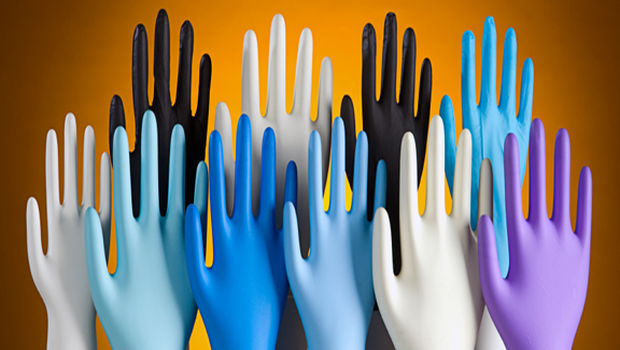FDA Warns, Don't be Misled by 'Latex-Free' Claims
If you’re allergic to natural rubber latex, the Food and Drug Administration (FDA) has good news for you: in the future, you are less likely to be misinformed about the absence of this allergen in such products as medical devices. To avoid false assurances about this hazard, the FDA is recommending to manufacturers to stop using the labels “latex free” or “does not contain latex.” The reason for this recommendation is that the agency is not aware of any tests that can show a product contains no natural rubber latex proteins that can cause allergic reactions


Natural rubber latex is used in the manufacture of various FDA-regulated products, such as condoms and medical gloves. Here, a physical science technician inspects medical gloves in related integrity testing at an FDA laboratory in Irvine, Calif. Photo courtesy of the FDA
If you’re allergic to natural rubber latex, the Food and Drug Administration (FDA) has good news for you: in the future, you are less likely to be misinformed about the absence of this allergen in such products as medical devices. To avoid false assurances about this hazard, the FDA is recommending to manufacturers to stop using the labels “latex free” or “does not contain latex.” The reason for this recommendation is that the agency is not aware of any tests that can show a product contains no natural rubber latex proteins that can cause allergic reactions. Without a way to verify that a product is completely free of these proteins, a claim that it is "latex free" is scientifically inaccurate and may be misleading.
FDA’s final guidance document, issued on Dec. 2, 2014, advises firms who want to indicate that natural rubber latex was not used in the manufacturing of their product, to state on the label that it was "not made with natural rubber latex."
Natural rubber latex is made from plant sources such as the sap of the Brazilian rubber tree. It is used in numerous medical products, including adhesive bandages, condoms, medical gloves, catheters, sanitary napkins, crutches and blood-pressure monitoring cuffs. Exposure can result in sensitivity to natural rubber latex proteins, with symptoms ranging from skin redness, rash, hives or itching to difficulty breathing and wheezing. Rarely, shock and even death can occur.
It is not possible to predict in advance just how much exposure to natural rubber latex might cause reaction in any specific person.
Who is at Risk?
Since sensitivity is more likely to build up over time, healthcare workers and others who frequently wear latex gloves are at highest risk.
The Occupational Safety and Health Administration (OSHA) estimates that 8 percentto 12 percent of healthcare workers are latex-sensitive. Workers in plants that produce natural rubber latex or that manufacture products containing natural rubber latex might also be at greater risk. FDA estimates that 1 to 6 percent of the general population may also be sensitive to natural rubber latex.
The National Institute for Occupational Safety and Health of the Centers for Disease Control and Prevention and OSHA recommend anyone with ongoing exposure to natural rubber latex to take the following steps for protection from allergic reactions:
• Use nonlatex gloves for activities that involve contact with biological materials including blood and bodily fluids whenever possible.
• In addition, use nonlatex gloves for activities that are not likely to involve contact with blood and bodily fluids, such as house cleaning, yard work, wall painting, etc.
• If you choose latex gloves for appropriate barrier protection, use powder-free gloves labeled as having reduced protein content. Natural rubber latex proteins can become attached to powder used to lubricate gloves and when the gloves are removed, the particles become airborne and can be inhaled, which is another form of exposure. Also when wearing gloves, do not use oil-based lotions since they can cause the gloves to deteriorate.
• After use, wash your hands with a mild soap and dry them thoroughly.
• If you have a natural rubber latex allergy, tell your physician, dentist, nurses and employer, and avoid contact with gloves and products made with natural rubber latex.
The Danger of Inaccurate Labeling
FDA’s medical device regulations require certain labeling statements on medical devices if the device or device packaging is made of natural rubber latex. At this time, there are no regulations requiring a company to make any labeling statements when natural rubber latex is not used as a material in the manufacturing of a medical product. However, some manufacturers have included such labeling statements as “latex free” or “does not contain latex” in their labeling. FDA believes that these labeling statements are not sufficiently specific, not necessarily scientifically accurate and may be misunderstood or applied too widely. Therefore, it is inappropriate to include such statements in medical product labeling.
Statements such as "latex free" are not specific about the type of latex involved and can cause confusion. Not all types of latex are from natural rubber and contain the proteins responsible for natural rubber latex allergy. For example, products containing nitrile and polyvinyl chloride are made of synthetic latex that does not contain those proteins and will not cause a latex allergy. Further, these statements do not account for the potential for accidental contamination of the medical product with natural rubber latex allergens during manufacturing or packaging.
Source: FDA
The Guardians of Animal Health: Who Are Veterinary Infection Preventionists?
March 21st 2025Veterinary infection control experts Leslie Kollmann, BS, AAS, CVT, CIC, Denise Waiting, LVT, and Leslie Landis, LVT, BS, discuss challenges, zoonotic disease risks, and the importance of education, collaboration, and resource development in animal care facilities.